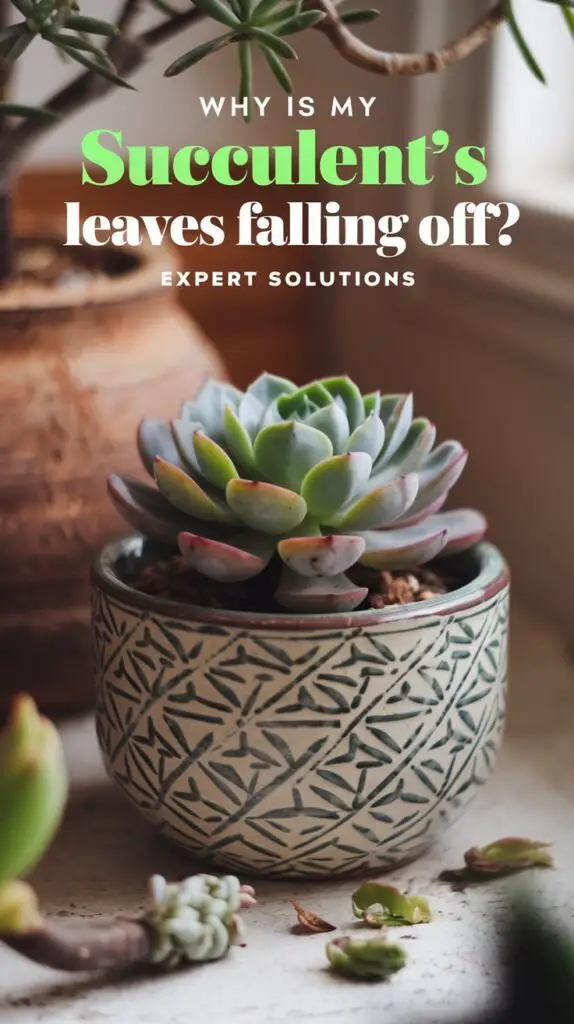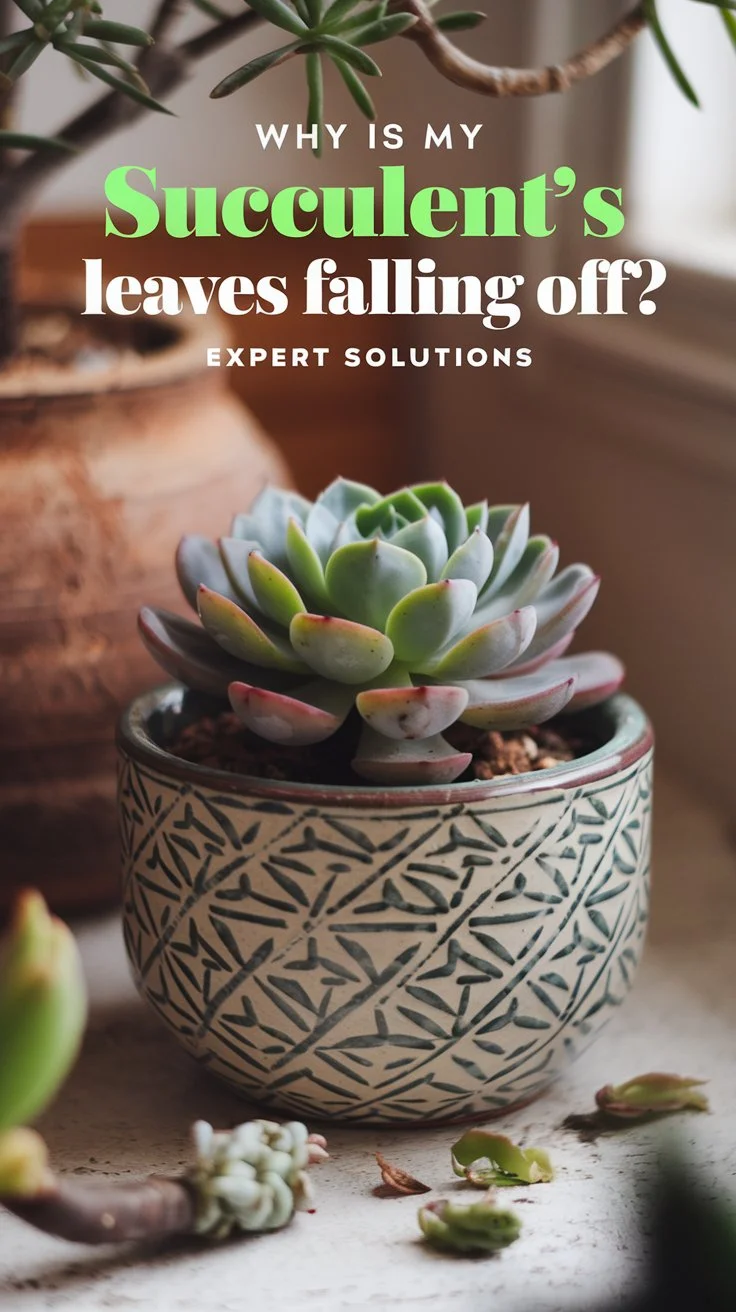Discover why your succulent’s leaves are falling off with our comprehensive 2024 guide. Learn about overwatering, underwatering, pests, and other causes. Get expert tips to save your plant!
Succulent leaves falling off can be alarming for plant owners, but it’s often a sign that your plant needs attention rather than a death sentence. This comprehensive guide explores the common causes of leaf loss in succulents and provides expert solutions to nurse your plants back to health. Whether you’re a seasoned succulent enthusiast or a beginner, understanding why succulent leaves fall off is crucial for maintaining healthy, thriving plants.

As a botanist specializing in xerophytic plants with over two decades of experience, I’ve encountered nearly every succulent issue imaginable. Let’s dive into the world of succulent care and uncover the mysteries behind falling leaves!
Common Reasons for Succulent Leaf Loss
Succulent leaves can fall off for various reasons, ranging from natural processes to stress responses. Here are the most common causes:
1. Overwatering
Why It Happens: Excessive water causes root rot, leading to leaf drop as the plant can’t absorb nutrients.
How to Identify:
- Leaves feel soft and mushy
- Yellowing or translucent leaves
- Soil remains wet for days after watering
2024 Update: New soil moisture sensors designed specifically for succulents are helping gardeners prevent overwatering.
Solution:
- Reduce watering frequency
- Ensure well-draining soil
- Use pots with drainage holes
Pro Tip: Wait until the soil is completely dry before watering again.
2. Underwatering
Why It Happens: Insufficient water causes the plant to conserve resources by shedding leaves.
How to Identify:
- Leaves feel thin and crispy
- Wrinkled or puckered leaf surface
- Soil is bone dry and pulling away from the pot sides
2024 Trend: Self-watering pots with customizable settings for succulents are gaining popularity.
Solution:
- Increase watering frequency slightly
- Use the “soak and dry” method
- Consider your succulent’s natural habitat
Pro Tip: When you do water, make sure to thoroughly soak the soil.
3. Insufficient Light
Why It Happens: Lack of light causes the plant to etiolate and shed lower leaves.
How to Identify:
- Plant becomes “leggy” with stretched stems
- New growth is pale or yellowish
- Leaves falling primarily from the bottom
2024 Innovation: New LED grow lights mimicking natural sunlight patterns are improving indoor succulent care.
Solution:
- Move the plant to a brighter location
- Introduce grow lights if natural light is limited
- Rotate the plant regularly for even light exposure
Pro Tip: Most succulents prefer 6 hours of bright, indirect sunlight daily.
4. Pest Infestation
Why It Happens: Pests like mealybugs or spider mites can cause leaf drop by damaging the plant.
How to Identify:
- Visible insects or webbing on the plant
- Sticky residue on leaves or surrounding surfaces
- Unexplained leaf discoloration or deformities
2024 Research: Studies are exploring natural predators as a sustainable pest control method for indoor plants.
Solution:
- Isolate affected plants
- Treat with neem oil or insecticidal soap
- Improve air circulation around plants
Pro Tip: Regularly inspect your succulents for early signs of pest infestation.
5. Temperature Stress
Why It Happens: Extreme temperatures, especially cold, can cause leaf drop as a stress response.
How to Identify:
- Leaves turning black or translucent after cold exposure
- Sudden leaf drop following temperature changes
- Soft, mushy leaves in extreme heat
2024 Trend: Climate-controlled mini-greenhouses for indoor use are becoming more accessible for succulent enthusiasts.
Solution:
- Keep succulents away from drafts and heat sources
- Protect outdoor succulents during temperature extremes
- Gradually acclimate plants to new environments
Pro Tip: Most succulents prefer temperatures between 60-80°F (15-27°C).
6. Natural Aging Process
Why It Happens: As succulents grow, they naturally shed older, lower leaves.
How to Identify:
- Only lower leaves are falling off
- Plant otherwise appears healthy and growing
- Leaf loss is gradual and minimal
2024 Update: New research is helping gardeners understand the optimal growth patterns for various succulent species.
Solution:
- This is normal; no action required
- Remove fallen leaves to prevent pest issues
- Appreciate your succulent’s natural life cycle
Pro Tip: Use fallen leaves for propagation to create new plants!
Best Practices for Preventing Succulent Leaf Loss
To maintain healthy succulents and minimize leaf loss:
- Use well-draining soil specifically formulated for succulents and cacti.
- Water deeply but infrequently, allowing soil to dry completely between waterings.
- Provide adequate light, using grow lights if necessary.
- Maintain proper temperature and humidity levels for your specific succulent species.
- Regularly inspect plants for signs of pests or disease.
- Avoid overcrowding plants to ensure good air circulation.
- Fertilize sparingly during the growing season with a balanced, diluted fertilizer.
Nurturing Healthy Succulents
Understanding why your succulent’s leaves are falling off is the first step in providing better care for these unique plants. By addressing the root cause, whether it’s overwatering, light issues, or natural aging, you can help your succulents thrive and display their full beauty.
Remember, every succulent species has slightly different care requirements. Take the time to research your specific varieties and don’t be discouraged if you experience some leaf loss – it’s all part of the learning process in succulent care.
For more information on succulent care and troubleshooting, visit resources like the Cactus and Succulent Society of America or consult with your local botanical garden. Happy growing, and may your succulents flourish with vibrant, plump leaves!
For more gardening tips and plant care guides, visit usagardenhub.com.




